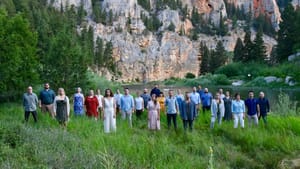Stay in the Loop
BSR publishes on a weekly schedule, with an email newsletter every Wednesday and Thursday morning. There’s no paywall, and subscribing is always free.
Time without a calendar
The Crossing presents Gavin Bryars’s ‘A Native Hill’

“[The hill] has nothing to do with a dial or calendar. Time is told in it mutely and immediately.” As day moved into night, The Crossing explored the passage of time in their world premiere of A Native Hill, a concert-length a cappella cantata of sublimely layered song and words, sublimely delivered by Donald Nally and his remarkable ensemble.
The title and text come from a 1968 Hudson Review essay by revered Kentucky farmer, poet, essayist, and conservationist Wendell Berry (b. 1934). For more than 50 years, Berry has tilled his land and told its story in novels and Thoreau-like observations that expand into philosophic musings.
It was this expansive quality—and the force of Berry’s ideas—that inspired noted British composer and polymath Gavin Bryars (b. 1943) to create this 75-minute work as a gift to The Crossing. The composer’s previous collaboration with the ensemble, The Fifth Century, won a Grammy award.
Settling in to explore
In his program notes, Bryars says that “Berry’s descriptions of the minutiae of his rural existence have a profound metaphysical and even political force.” The sung text (1500 words excerpted from the 34-page essay) is entirely large swaths of prose, so Bryars faced a formidable challenge in setting it. The poet’s verbal distillation and rhythmic underlay are innately musical. But the essayist leads a reader through a process, either to a conclusion or a call for further exploration.
To effectively render a prose text that explores cyclic natural rhythms, Bryars brilliantly makes his music rise and fall with Berry’s carefully calibrated sentence structures, bowing to this phraseology and illuminating the prose. A Native Hill is the musical equivalent of a New Yorker essay, where musical and intellectual ideas are developed, not thrust upon you. You must settle in for an exploratory journey.
Each of the work’s 12 movements is a long swath of pastoral prose rife with symbolism. In Movement I, “The Sense of the Past,” the composer establishes a lush harmonic palette of overlapping lines, matching Berry’s description of the countryside as a “palimpsest scrawled over with the comings and goings of people.” Here, Bryars introduces his two centering devices: brief melodies continually emerge and retreat, and he often resolves into reassuring chords or comforting hymn-like cadences that pull the work back from the cerebral and ground it in the familiar.
The path, the stream, the creatures, the shadow
Movement II, “The Path,” sets up the work’s philosophical tenet, and throughout 10 subsequent sections, Bryars evocatively crafts music in harmony with Berry’s text. In “Sea Level,” baritones describe what lies beneath the hills, while sopranos sing about “the highest ridgetops.” In “The Road,” a path appears “out of the earth and [ends] in it, bearing no load but the hawk’s kill,” and Bryars gives the section a chilling change in emotional intensity.
Movement VI opens with exquisite, near-classical motifs as Berry listens “to the music of streams to prepare to hear someday the music of the spheres.” In Movement VII, questions are “religious because they are asked at the limits of what I know.” Here, as the work turns more overtly philosophical, Bryars’ contrasting dynamics create deep longing.
There is a break in intensity in “Animals and Birds,” where the composer interprets “a great peacefulness” to include gentle, slightly humorous insertions of humming and whistles into a musical landscape that evokes the Edward Hicks painting The Peaceable Kingdom.
In Movement XI, “every man is followed by a shadow which is his death” until “what has hounded him becomes his companion.” Bryars opens with a mezzo solo (sung with deep longing) and then undergirds it with a thrumming baritone passage.
A majestic work
This journey into an acceptance of death ends hopefully. “At Peace,” the final movement, begins with a stunning 24-voice chromatic cluster that underscores a haunting meditation on the fall of an autumn leaf reminiscent of Thornton Wilder’s Our Town. Bryars ends this magnificent work with a warmly harmonic resolution, and Nally lets the music reverberate into an elongated silence.
At last December’s concert, when the ensemble sang excerpts from this work, they seemed dense and out of place. But heard in its entirety, this is a majestic work. Bryars created it for The Crossing, employing his “intimate knowledge of the singers’ individual characteristics,” and he was in the audience for its exceptional realization.
Projected supertitles were especially helpful in this text-based work, which was recorded for a future WRTI broadcast. Throughout, the choir sang with crystalline tonality and impeccable ensemble, and Nally’s love of the high-soaring soprano sound was (as always) apparent. But in preparing and conducting this work, the director was also inspired to create a lush, warm sound that perfectly matched Bryars’s exploration and embrace of Berry’s remarkable prose.
The new BSR reader survey is live, and we want to hear from you! Complete this quick questionnaire, and we’ll enter you in a gift certificate drawing good for two tour tickets with Mural Arts Philadelphia.
What, When, Where
A Native Hill. By Gavin Bryars, to text from an essay by Wendell Berry. Conducted by Donald Nally. October 13, 2019 at Presbyterian Church of Chestnut Hill 8855 Germantown Avenue, Philadelphia. crossingchoir.org.
The Presbyterian Church of Chestnut Hill is wheelchair-accessible.
Sign up for our newsletter
All of the week's new articles, all in one place. Sign up for the free weekly BSR newsletters, and don't miss a conversation.

 Gail Obenreder
Gail Obenreder